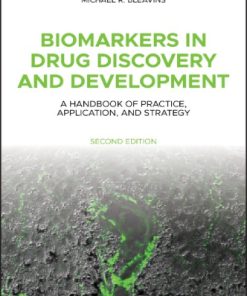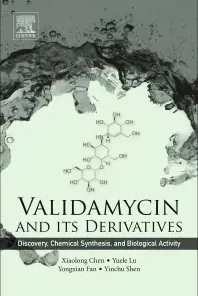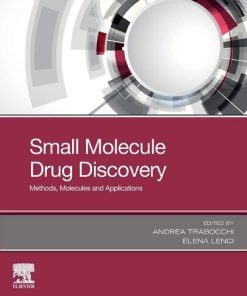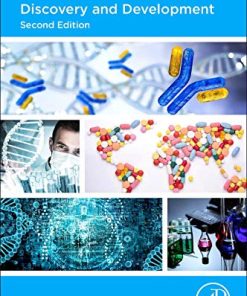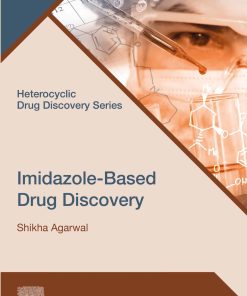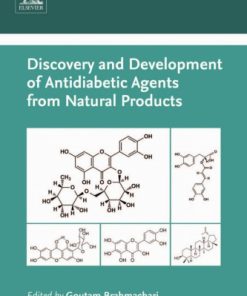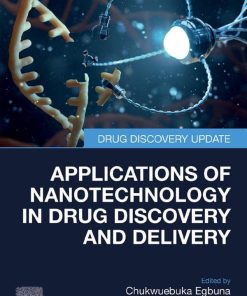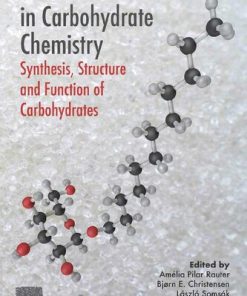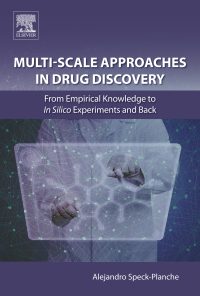(EBook PDF) Carbohydrates in Drug Discovery and Development Synthesis and Application 1st Edition by Vinod Tiwari 0128166762 9780128166765 full chapters
$50.00 Original price was: $50.00.$25.00Current price is: $25.00.
Carbohydrates in Drug Discovery and Development: Synthesis and Application 1st Edition by Vinod K. Tiwari – Ebook PDF Instant Download/DeliveryISBN: 0128166762, 9780128166765
Full dowload Carbohydrates in Drug Discovery and Development: Synthesis and Application 1st Edition after payment.
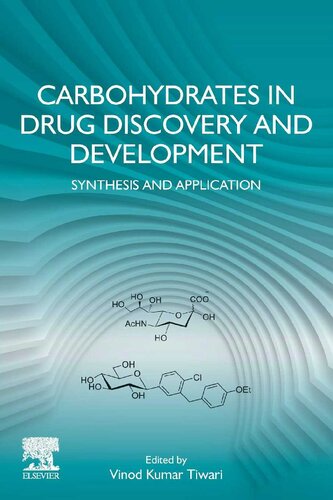
Product details:
ISBN-10 : 0128166762
ISBN-13 : 9780128166765
Author: Vinod K. Tiwari
Carbohydrates in Drug Discovery and Development: Synthesis and Applications examines recent and notable developments in the synthesis, biology, therapeutic, and biomedical applications of carbohydrates, which is considered to be a highly promising area of research in the field of medicinal chemistry. Their role in several important biological processes, notably energy storage, transport, modulation of protein function, intercellular adhesion, malignant transformation, signal transduction, viral, and bacterial cell surface recognition formulate the carbohydrate systems to be an exceedingly considerable scaffold for the development of new chemical entities of pharmacological importance. In addition to their easy accessibility, high functionality and chiralpool characteristics are the few additional fascinating structural features of carbohydrates, which further enhance their utilities and thus they have been able to attract chemists and biologists toward harnessing these properties for the past several decades.
Carbohydrates in Drug Discovery and Development: Synthesis and Application 1st Table of contents:
Chapter One – Recent trends and challenges on carbohydrate-based molecular scaffolding: general cons
1 – Introduction
2 – Biological significance of carbohydrates and their impact in drug discovery
2.1 – Carbohydrates on cell surface
2.2 – Carbohydrate for genetic information
2.3 – Importance of furanose structure
2.4 – Heparin: a natural anticoagulant
3 – Carbohydrate-based drugs
3.1 – Naturally occurring carbohydrates and their derivatives as drug candidates
3.2 – Carbohydrate scaffolds in nature and their impact in drug development
3.3 – Carbohydrate-based antibiotics
3.4 – Carbohydrate-based anti-cancer agents
3.5 – Carbohydrate-based anti-diabetic agents
3.5.1 – Glycosidase inhibitors with anti-diabetic effects
3.5.2 – Sodium dependent glucose co-transporter inhibitors
3.6 – Carbohydrate-based anti-tubercular agents
3.7 – Carbohydrate-based anti-parasitic agents
3.8 – Carbohydrate-containing molecules as anti-HIV agents
3.9 – Carbohydrate-based anti-coagulants
3.10 – Carbohydrate-mimetics as potential sialyltransferase inhibitors
3.11 – Carbohydrate-based potential glycosidase inhibitors
3.12 – Cardiac glycosides as therapeutics
3.13 – Carbohydrate-based molecules with miscellaneous activities
4 – Carbohydrate-based metallo drugs
5 – Carbohydrate-based vaccines
6 – Conclusions and future perspective
Acknowledgments
References
Chapter Two – Heparin mimetics as tools for modulation of biology and therapy
1 – Introduction
2 – Heparin mimetics as anti-coagulants
3 – Heparin mimetics as growth factor binders
4 – Heparin mimetics as heparanase inhibitors
5 – Conclusion and future perspectives
Acknowledgments
References
Chapter Three – Bioactive C-glycosides inspired from natural products towards therapeutics
1 – Introduction
2 – Glycosides in nature
3 – C-Glycosides: an introduction
4 – Synthesis of bioactive C-glycosides
5 – C-Glycoside: Dapagliflozin, a novel drug in the market for diabetes
5.1 – Proximal ring modifications in Dapagliflozin
5.2 – Modification in the glycone part of Dapagliflozin
6 – C-Glycosides of flavones
7 – C-Glycosides of chalcones
8 – C-glycosides of xanthones
9 – C-Glycosides inspired from Adenophostin A
10 – C-Glycosides of KRN 7000
10.1 – Sugar ring annulation for the access to C-glycosides
11 – C-Glycosides: annulating glycone and aglycone part, an illustration
12 – C-1 functionalized building blocks for synthesis of C-Glycosides
12.1 – Applications of C-1 functionalized building blocks
13 – Conclusions and future perspectives
References
Chapter Four – 3-Deoxy-d-manno-oct-2-ulosonic acid (Kdo) derivatives in antibacterial drug discovery
1 – Introduction
2 – Total syntheses of Kdo
2.1 – Total synthesis of Kdo from D-arabinose
2.2 – Total synthesis of Kdo from d-mannose
2.3 – Total synthesis of Kdo from d-mannitol
2.4 – Total synthesis of Kdo from other precursors
3 – Synthesis of Kdo derivatives as potential inhibitors of Kdo-processing enzymes
3.1 – Total synthesis of 2-deoxy-β-Kdo
3.2 – Synthesis of 2-deoxy-β-Kdo derivatives
3.3 – Synthesis of Kdo C-glycosides
3.4 – Synthesis of Kdo O-glycosides
3.5 – Synthesis of miscellaneous Kdo derivatives
4 – Kdo derivatives for LPS labeling of living organisms
5 – Conclusions and future perspectives
References
Chapter Five – Sialic acid-containing molecules in drug discovery and development
1 – Introduction
2 – Some representative characteristics of sialic acids
2.1 – Sialic acid as terminal sugars
2.2 – Sialic acid has great structural complexity
2.3 – Occurrence of sialic acids
2.4 – Sialic acids have a great biological significance
2.5 – Biosynthesis of diverse sialosides in eukarotic and prokaryotic system
2.6 – Enzymatic synthesis of sialylated glycans
3 – Common synthetic routes for sialic acid containing molecules
3.1 – Chemical glycosylation
3.1.1 – Modifications at C-1
3.1.2 – Modifications at C-2: leaving groups
3.2 – Chemo-enzymatic synthesis for the designing sialoside libraries
4 – Sialic acid-containing molecules in drug development
5 – Synthesis of some commercially available drugs
5.1 – Zanamivir and oseltamivir as neuraminidase inhibitors
5.2 – Synthesis of zanamivir from N-acetylneuraminic acid (NANA) by the Merck Frosst Centre, Canada
5.3 – Scalable route to zanamivir by Glaxo
5.4 – First scalable synthesis of oseltamivir phosphate from (-)-quinic acid by Gilead Sciences Inc
6 – Sialic acid in neurobiology: opportunity and challenges
6.1 – Disorders associated with sia
6.1.1 – Sialic acid storage disorder
6.1.2 – Sialuria and salla disease
6.1.3 – Guillain–barré syndrome
6.1.4 – Miller fisher syndrome
6.1.5 – Schrizophenia
6.1.6 – Autism spectrum disorder (ASD)
6.1.7 – Alzheimer’s disease (AD)
6.2 – Uses in neurobiology
6.2.1 – As biomarker
6.2.2 – ‘Sia’ as drug for disorders
7 – Conclusions and future perspective
Acknowledgments
References
Chapter Six – Glycan microarray: Toward drug discovery and development
1 – Introduction
2 – Fabrication of glycan microarrays
3 – Detection of glycan microarrays
4 – Biomedical applications of glycan microarrays
4.1 – Cancer
4.2 – Infectious diseases
4.3 – Autoimmune diseases
4.4 – Vaccine development
4.5 – Enzyme inhibitors
5 – Conclusions
References
Chapter Seven – Recent developments in the synthesis of biologically relevant inositol derivatives
1 – Introduction
2 – Structure, nomenclature of myo-inositol and associated implications for synthesis
3 – Inositols and their derivatives: the biological and medicinal context
4 – Strategies for the synthesis of inositol derivatives
4.1 – Necessity versus current state of art
4.2 – Synthesis of inositol derivatives from myo-inositol– relative reactivity of the hydroxyl gro
4.3 – Synthesis of enantiomeric myo-inositol derivatives from chiral precursors
4.4 – Enantiomeric inositol derivatives from myo-inositol
4.5 – Resolution of racemic myo-inositol derivatives by conversion to separable diastereomers
4.6 – Enzyme mediated resolution of racemic myo-inositol derivatives
4.7 – Desymmetrization of symmetric myo-inositol derivatives
4.8 – Phosphorylation of inositol derivatives
5 – Conclusions and future outlook
References
Chapter Eight – Iminosugars
1 – General introduction
1.1 – Glycoconjugate processing enzymes
1.2 – Inhibitors of glycosidases
1.3 – Classifications of carbohydrate-derived inhibitors
1.4 – Iminosugars
2 – Iminosugars as inhibitors glycosidases
2.1 – Mode of action
2.2 – Structural basis for glycosidase inhibition by iminosugars
3 – Classification of naturally occuring iminosugars
3.1 – Natural polyhydroxypiperidines and their source of isolation
3.2 – Natural polyhydroxypyrrolidines and their source of isolation
3.3 – Naturally occurring polyhydroxyindolizidines and their source of isolation
3.4 – Naturally occurring polyhydroxypyrrolizidines and their source of isolation
3.5 – Naturally occurring nortropanes and their source of isolation
4 – Iminosugars as inhibitors of glycosidases
4.1 – Iminosugars as inhibitors of α-glucosidases
4.2 – Iminosugars as inhibitors of β-glucosidases
4.3 – Iminosugars as inhibitors of α-galactosidases
4.4 – Iminosugars as inhibitors of β-galactosidases
4.5 – Iminosugars as inhibitors of mannosidases
4.6 – Iminosugars as inhibitors of α-L-fucosidases
4.7 – Iminosugars as inhibitors of α-l-rhamnosidoses
4.8 – Iminosugars as inhibitors of β-N-acetylhexosaminidases
4.9 – Iminosugars as inhibitors of glycogen phosphorylase
5 – Iminosugars as antivirals
6 – Iminosugars as pharmacological chaperones for lysosomal storage diseases
7 – Conclusions and future scope
References
Chapter Nine – Carbohydrate-protein interactions: Enhancing multivalency effects through statistical
1 – Introduction
1.1 – ConA
1.2 – DC-SIGN
1.3 – PNA
1.4 – Jack bean α-mannosidase
2 – Conclusion and future perspectives
References
Chapter Ten – Carbo-click in drug discovery and development: Opportunities and challenges
1 – Introduction
2 – Carbo-click in drug discovery and development
2.1 – Traizolyl glycoconjugates as enzyme inhibitors
2.1.1 – Carbonic anhydrase inhibitor
2.1.2 – Glycosyl transferase inhibitors
2.1.3 – Trypanosoma cruzi trans-sialidase (TcTS) inhibitor
2.1.4 – Glycosidase inhibition activity
2.1.5 – Neuraminidase inhibitors
2.1.5.1 – Zanamivir based neuraminidase inhibitors
2.1.5.2 – DANA based neuraminidase inhibitors
2.1.5.3 – Sialic Acid based Neuraminidase inhibitors
2.1.6 – Glycogen phosphorylase inhibitor
2.1.7 – Protein tyrosine phosphatases (PTPs) inhibitors
2.2 – Pharmacological applications of click chemistry
2.2.1 – Anti-cancer activities
2.2.2 – Anti-leishmanial activity
2.2.3 – Anti-fungal and anti-bacterial activities
3 – Conclusion and future perspectives
Acknowledgments
References
Chapter Eleven – Glycohybrid molecules in medicinal chemistry: Present status and future prospective
1 – Introduction
2 – Bioactive carbohybrid molecules
2.1 – Anticancer activity
2.1.1 – Antiviral activity
2.2 – Immunomodulatory activity
2.3 – PTP1B inhibitors
2.4 – Carbonic anhydrase inhibitor
2.5 – Antimalarial activity
2.6 – Antifungal activity
2.7 – Antibacterial activity
2.8 – Glycosidase inhibitor activity
2.9 – Galectin-3 inhibitors
2.10 – Anti-inflammatory
3 – Conclusion and future prospective
References
Chapter Twelve – Biologically active carbohydrate-containing macrocycles
1 – Introduction
1.1 – Macrocyclic carbohydrates isolated from plants
1.2 – Macrocyclic carbohydrates isolated from microorganisms
1.3 – Natural carbohydrate-based macrocycles as drug candidate
1.4 – Macrocyclic carbohydrates used for the drug delivery
1.5 – Macrocyclic carbohydrates as marketed drugs
1.6 – Macrocyclic carbohydrates as antibiotics
1.7 – Macrocyclic carbohydrates as anti-fungal drugs
1.8 – Macrocyclic carbohydrates as immune suppressants or immunomodulators
2 – Synthesis of some macrocyclic carbohydrates
2.1 – Synthesis of carbohydrate macrocycles possesing sugar part as core molecule
3 – Conclusions and future perspectives
Acknowledgment
References
Chapter Thirteen – Carbohydrate-based antibiotics: Opportunities and challenges
1 – Introduction
1.1 – Carbohydrates-containing antibiotics
2 – Aminoglycoside antibiotics
2.1 – Recent progress in design of novel aminoglycosides
3 – Nucleoside antibiotics
3.1 – Pyrimidine analogues
3.2 – Fluorinated pyrimidines
3.3 – Thiopurines
4 – Macrolide antibiotics
5 – Glycopeptide antibiotics
6 – Conclusions and future perspectives
References
Chapter Fourteen – Carbohydrate-based anti-bacterial and anti-cancer vaccines
1 – Introduction
2.1 – Challenges associated with carbohydrate-based vaccines
2.2 – Design of glycoconjugate vaccines
2.2.1 – Synthesis of glycoconjugates as vaccine candidates
2.3 – Anti bacterial glycoconjugate vaccine
2.4 – Anti-tumour and anti-cancer carbohydrate vaccines
3 – Conclusions and future perspectives
References
Chapter Fifteen – Opportunity of plant oligosaccharides and polysaccharides in drug development
1 – Introduction
2 – Biological and pharmacological significance
2.1 – Starch and its products
2.2 – Monosaccharide based natural polyols
2.3 – Cellulose and its derivatives
2.4 – Exudate gums
2.5 – Glycoconjugates
3 – Plant oligosaccharide based molecules
4 – Plant polysaccharide based drugs
4.1 – Antidiabetic activity
4.2 – Immunomodulatory activity
5 – Structure-activity relationship
6 – Polysaccharides in drug delivery
7 – Bioactive polysaccharides: Structural aspects
8 – Conclusions
9 – Future perspectives
References
Chapter Sixteen – N-acetylgalactosamine (GalNAc)-conjugates: Delivering oligonucleotide drugs to the
1 – Introduction
1.1 – Oligonucleotide therapeutics
1.2 – Oligonucleotide therapeutics: Mode of action
1.3 – Oligonucleotide therapeutics: Challenges
1.4 – Medicinal chemistry of therapeutic oligonucleotides
1.5 – Phosphate-backbone modifications
1.6 – Sugar modifications
1.7 – Combining the sugar and phosphate-backbone modifications
1.8 – Complete replacement of the sugar-phosphate backbone
1.9 – Nucleobase modifications
1.10 – Covalent-conjugate approach: GalNAc-conjugates
1.11 – GalNAc-conjugates: mechanism of liver-specific delivery
1.12 – GalNAc-conjugates: design
1.12.1 – Triantennary GalNAc
1.12.2 – Monomeric linear GalNAc
1.13 – Further improvements in GalNAc-oligonucleotide conjugates
People also search for Carbohydrates in Drug Discovery and Development: Synthesis and Application 1st:
carbohydrate drugs
carbohydrates as drug targets
carbohydrates in dna
carbohydrates in medicine
a carbohydrate molecule
You may also like…
Medicine - Molecular Medicine
Science (General)
Chemistry
Small Molecule Drug Discovery Molecules and 1st Edition by Andrea Trabocchi 0128183500 9780128183502
Chemistry - Organic Chemistry
Basic Principles of Drug Discovery and Development 2nd Edition
Chemistry - Organic Chemistry
Imidazole-Based Drug Discovery (Heterocyclic Drug Discovery)
Medicine - Pharmacology
Technique - Nanotechnology
Science (General)




